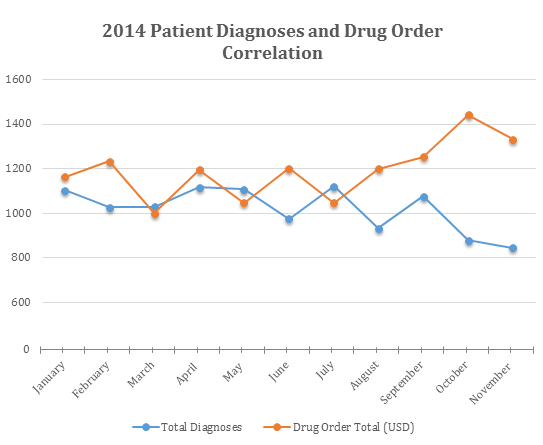Outcomes / Significant Drug Savings
Use of Electronic Medical Records for the Developing World (OutreachEMR) leading to drug cost savings of over $400 per month
Background
The clinic is set in rural Uganda and sees over 1000 patients per month. After a consultation, medication is dispensed without charge. In common with many clinics in the developing world, there is a limited formulary and when the monthly supply is exhausted, patients have to buy their medication elsewhere.
This inevitably creates opportunity for a black market .
Electronic Medical Records
Before this clinic had an electronic database, it was impossible to monitor which drugs were actually prescribed and compare this with the monthly drug order, let alone count the number of diagnoses made. Diagnoses count is a better indicator of costs than patient attendance.
How did we show evidence of misappropriation by use of EMR ? ( Electronic Medical Records)
By use of the OutreachEMR reporting data, we were able to plot the monthly diagnosis rate against the monthly drug order bills over a period of 10 months
The lower diagnoses count was partially due to lower attendance rates but also as a result of continuing professional development (CPD) and introduction of a culture amongst the clinicians that not all patients needed a prescription or a diagnosis, but rather would benefit from reassurance and education.
Rising drug costs and falling diagnoses led us to believe that some medicines were going missing along a complex pathway of these drugs from pharmacy to patient. In reality it is often impossible to monitor as closely as we do in the developed world.
Using the OutreachEMR system we audited the clinical notes of all attendances over a period of 3 months. We were able to list every tablet or medication that was prescribed in the clinic as this is how the clinician communicates with the pharmacist . We found a wide discrepancy between the number of drugs prescribed and the monthly order. We were able to pinpoint exactly what medicines were being misappropriated. Diazepam, Amoxicillin and Amitriptyline were all disappearing into the black market
As a result, the new manager of the clinic ( audit intitiator ) was able to tighten possible loopholes in the supply chain and the initial savings were descibed as follows …
"Last month, we were able to order two months' supply for UGS 2,450,000 ( $780 ) whereas before we took a look at all of it, it was nearly UGS 3,250,000 ( $1056 ) for ONE month"
This first audit is probably exceptional but we expect the overall savings to amount to $400 + per month which will probably save this clinic $5000 per annum

